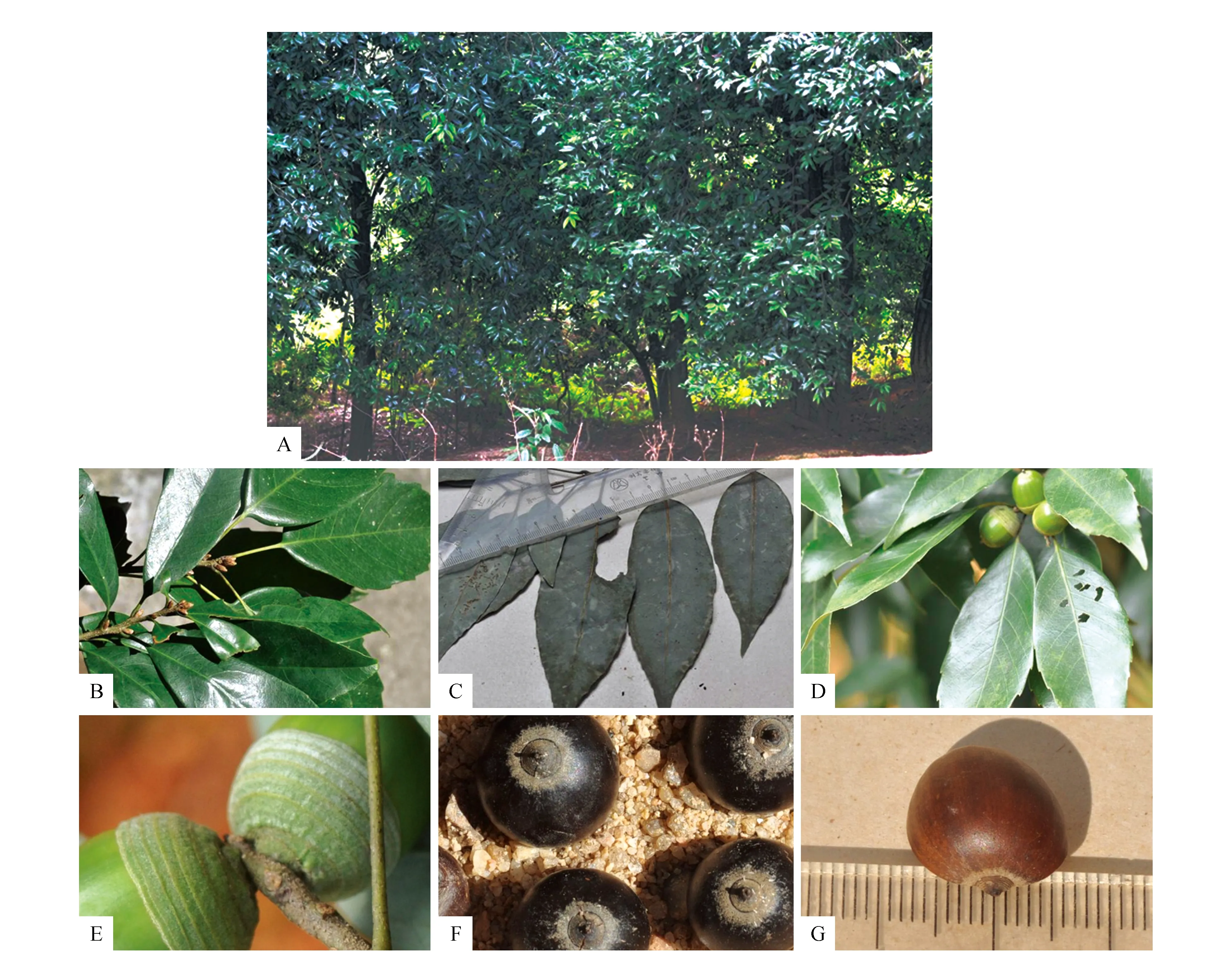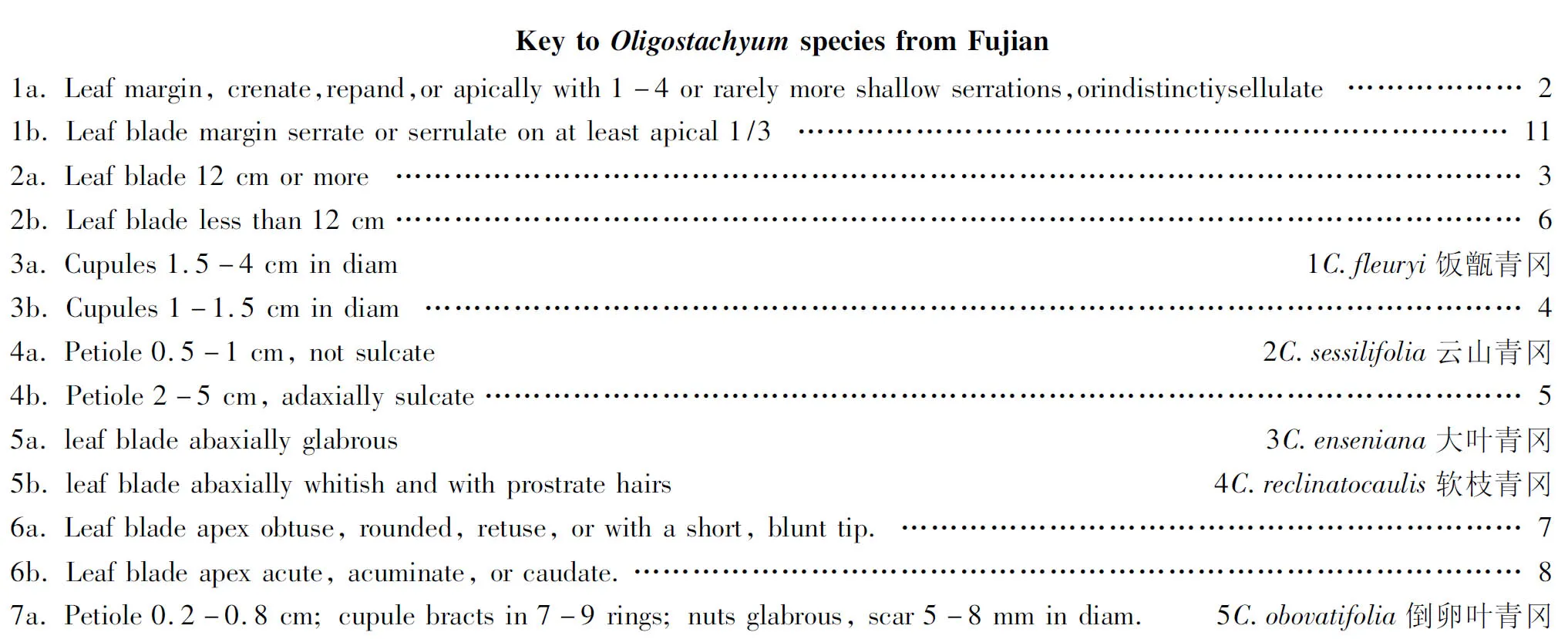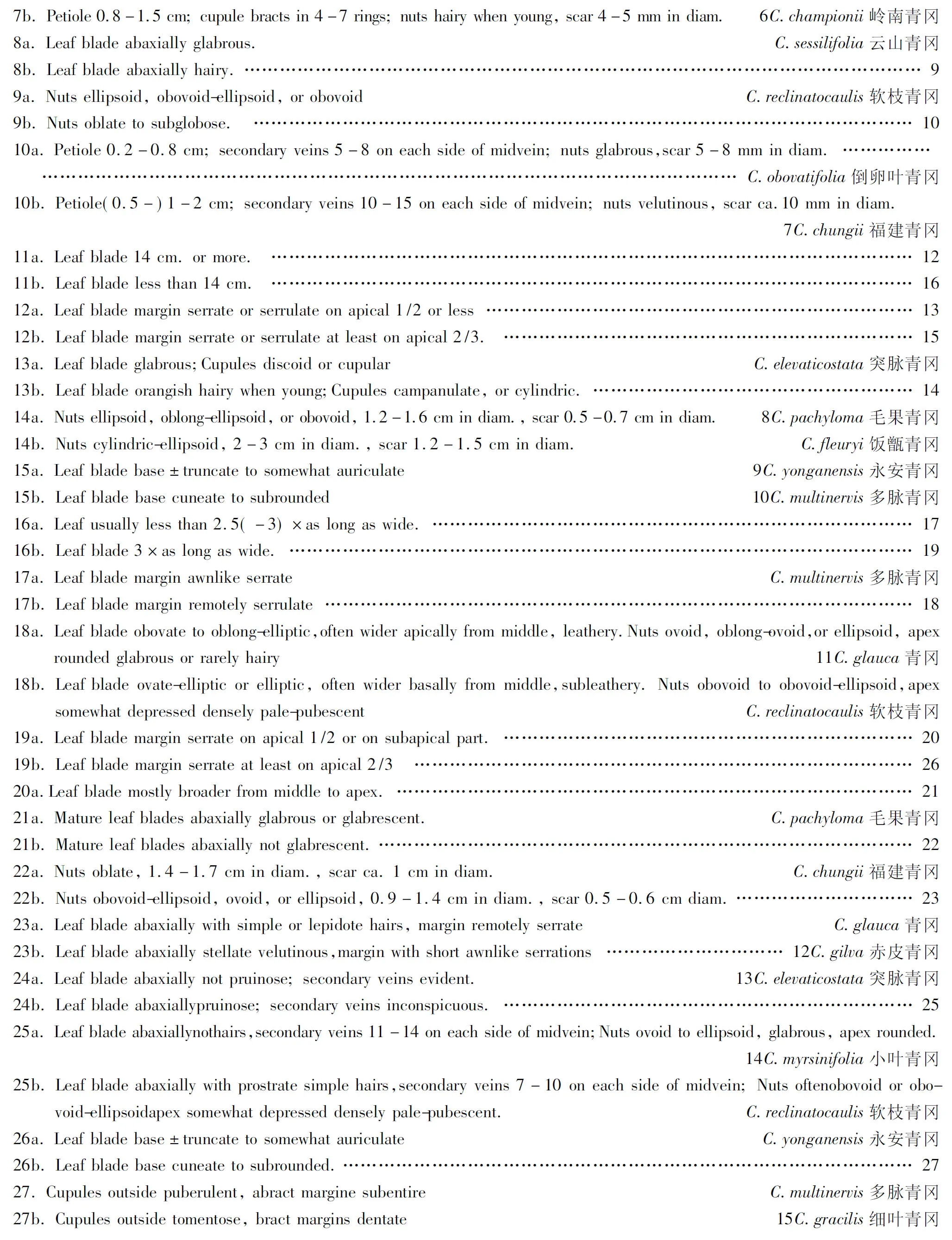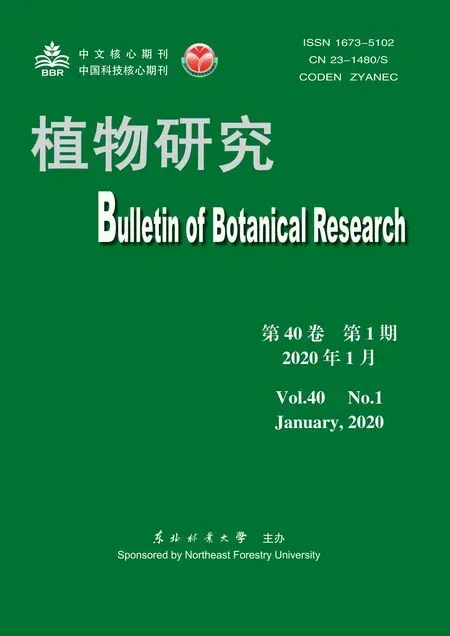软枝青冈,福建壳斗科一新种
2020-03-13林沁文钟益鑫林木木
林沁文 钟益鑫 林木木
(1.福建汀江源国家级自然保护区,长汀 366300; 2.福建省长汀县林业局,长汀 366300)
In 2012, the author surveyed the Guilong Mountain Nature Reserve, in early December, several plants of the genusCyclobalanopsiswere found near a small stream in Wantuan Village, Sidou Town. We consider them to beCyclobalanopsisglaucaplant ofCyclobalanopsisgenus. It is one the main forest plant species in our region. It has very distinct characteristics: Trees or rarely shrubs, evergreen. Trunk bark usually smooth. Winter buds ovoid-globose, ovoid-conical, or rarely ovoid-ellipsoid; scales many, imbricate. Stipules extrapetiolar. Leaves spirally arranged. Cupules solitary; bracts scalelike, whorled, in rings. Nut usually 1 per cupule. The plants we met, its nut are wrapped in a small bowl-shaped cupule, and the bracts of the outer wall of the cupule busket combine to form multiple rings. This fully accords with the main characteristics ofCyclobalanopsis. Within the scope of Changting County, there are eight species ofCyclobalanopsis. This plant is most similar toC.glauca, similar points are: leaf blade margin apical 1/2 serrulate, secondary veins 7-10 on each side of midvein; leaf blade abaxially often becoming pruinous and with prostrate white simple or scalelike hairs but glabrescent; Cupule bowl-shaped, outside white puberulent, bracts in rings, margin entire; Nuts are about the same size. Therefore, it will be mistaken forC.glaucafor a long time.
1 Materials and Methods
Since 2012, at its flowering and fruiting stages, it has been investigated and collected many times. After consulting national floras and other relevant literature[1~3], as well as numerous hebarium specimens, we found this particular species differed from all known ones.
Because even the most similarCyclobalanopsisgrauca, but after years of observation and research, it can’t beC.glauca. First, its winter buds arelight reddish brown(Fig.2:B), while the winter buds ofC.glaucaare light green; Secondly, it’s the leaf blade subleathery, usually abaxially dark gray when dry(Fig.2:C), the leathery leaves ofC.glaucaare still grayish-white after drying; Thirdly, it’s the cupule bracts in 8-10 rings(Fig.2:E), while 5-6 rings inC.glauca; Fourth, it’s the nuts are obovate or obovate-elliptic, with slightly depressed apex and densely pubescent, stylopodium persistent, slightly broad 3-4 mm in diam., conspicuous 7-8-ringed(Fig.2:F). The nuts ofC.glaucaare usually ovate to elliptic, with rounded apex, never depressed, hairless or slightly pubescent, the stylopodium is not more than 2 mm, only inconspicuous 5-6 rings. In fact, as long as a seed is picked up, taxonomic status can be determined. So we made the conclusion that this population is an undescribed species, and the valid nameCycpobalanopsisreclinatocaulisM.M.Lin was used which is described below.
2 Cyclobalanopsis reclinatocaulis M.M. Lin sp. nov.(Fig.1-2)
TypeFujian: Longyan City, Changting County, Sidou Town, Wantuan Village N25°36′24″, E116°46′01″; alt. s.m.500 m. properivulas in convallismontibus, 2013-10-16, Lin Qin-wen et al. 01-06; (Holotype, AU)(Certificate specimens are deposited in the Herbarium of Tingjiangyuan National Nature Reserve)
Featureset:C.reclinatocaulis, is close related toC.glauca. But this species differs fromC.glaucain its winter buds reddish-brown; leaf blade subleathery, often elliptic, ovate-elliptic, abaxiallyoften dark gray when dry, margin often shallow serrations; cupule bracts in 8-10 rings, crowded; nut obovoid to obovoid-ellipsoid, apex somewhat depressed, dense pale-pubescent; stylopodium slightly broad 3-4 mm in diam., 7-8-ringed.
Describe: Trees to 10 m tall. Winter buds ovoid-globose, ovoid-conical, reddish brown. Branchlets minutely sulcate, glabrous or sparsely villous when young, conspicuously lenticellate. Petiole 1-2.5 cm glabrous; leaf blade elliptic, ovate-elliptic or obovate-elliptic, 5-14 cm×2-4.5 cm, subleathery to when old leathery, abaxially often becoming pruinous and with prostrate white simple or scale like hairs but glabrescent, but dark gray when dry,adaxially glabrous, basecuneate, broadly cuneate to rounded, margin apical 1/2 remotely serrate or shallo serrations, apex acuminate to somewhat caudate; secondary veins 7-10(12) on each side of midvein; tertiary veins abaxially inconspicuous. Infructescences 1.5-3 cm, with 1 or 4 fruit. Cupule bowl-shaped, 6-10 mm×0.9-1.4 cm, enclosing 1/3-1/2 of nut, outside white puberulent or glabrous, inside white sericeous; bracts in 8 or 10 rings, crowded, margin entire. Nut obovoid or obovoid-ellipsoid, 0.8-1.6 cm×1.2-1.8 cm, apex somewhat depressed densely pale-pubescent; scar ca. 5 mm in diam., flat or slightly convex; stylopodium persistent, slightly broad 3-4 mm in diam., conspicuous 7-8-ringed, umbonate.

Fig.2 C.reclinatocaulis M.M.Lin A.Plant; B.Winter buds; C.Leaves when dry abaxially; D.Branches fruits and leaves; E.Cupule; F.Nuts apex; G.Nut size
Taxonomictreatment:Cyclobalanopsisplants are distributed in the tropical and subtropical regions of Asia, with about 150 species. According to volume 22 of the Chinese flora, there are 77 species in China[2]. After the merger of the same species, the English version of the Chinese flora contains 69 species[3]. According to the records of Fujian Flora, there are 14 species in my province[1]. A key to the known species ofCyclobalanopsisfrom Fujian is provided below.


Habitat,distributionandphenology:C.reclinatocaulisgrows in the valley of usually grows in evergreen broad-leaved forestes,near the stream, at an elevation about 600 m. sometimes it also grows in hillside of low altitude, the associated species containCastanopsisfaberii,C.fargesii,Liquidambarformosana,Sloaneasinensis,Camptothecaacuminata,Machilusphoenicis,Styraxsuberifolius,Rhamnusnapalensis,Fissistigmaoldhamii,Carexscaposa,Arachniodeschiensisand so on. At present,C.reclinatocaulisis only found in Tingjiangyuan National Nature Reserve, flowering occurs from April, ripening period October. The seed falls behind, no need to go through hibernation. It will germinate and grow into seedlings. This becomes the peculiar ecological features ofC.reclinatocaulis.
TheC.reclinatocaulisis found in the townships of Hongshan and Sidu at the junction Jiangxi Province is not high(the average elevation is less than 800 meters) and should be distributed to Jiangxi Province,therefore, we think it is a regional species conceived in the Southern section of the Wuyi Mountains, Western Fujian and southeastern Jianxi under subtropical climate conditions. It is common withC.glauca, but also sometimes born together. However, its flower and fruit it flower and fruit period is earlier, and it is basically ripe in mid-October each year, and it falls off in the later period. At this time, the fruit ofC.glaucais still standing up, so it is not easy to confuse.
Conservationstatus: Fujian Tingjiangyuan National Nature Reserve, with a total area of 10 379.7 hm2,C.reclinatocaulisis only known from the locality, and the total number of plants is less than 100, we therefore considerC.reclinatocaulisto be vulnerable(VU) according to the IUCN categories and criteria[4].
Discuss: Nuts ofC.reclinatocaulisits apex slightly depressed and densely fluffy,eight rings can be counted from thestylopodium column base, this can be distinguished from the common species ofC.glauca,CyclobalanopsisgracilisandCyclobalanopsismyrsinifoliain this region. Because, in Changting, from the specimens of these plants. The apex of the nut is rounded. It can also be seen from the Fig. of the three plants in the Flora of China that the top of their nuts are rounded[2].
We entrusted Engineer WU Jin-ping of “Meihuashan National Nature Reserve”, Look up ofCyclobalanopsisgrauca,CyclobalanopsisgracilisandCyclobalanopsismyrsinifolia, in their herb. The apex of their nuts is not depressed, but rounded. We also entrust Prof. LI Zhen-ji, Academy of Life Sciences, Xiamen University(Leading the Comprehensive Scientific Investigation of “Guilongshan provincial Nature Reserve” Promoting “Tingjiangyuan National Nature Reserve” in our County. He is the author of(Research on Biodiversity in the Tingjiangyuan Nature Reserve of Fujian). It also helps to collection the type ofC.reclinatocaulis). Look up the specimens ofC.glauca,CyclobalanopsisgracilisandCyclobalanopsismyrsinifolia, in the Herb, Confirm that the apex of their nuts is rounded. Furthermore, we have also carefully studied the genusCyclobalanopsisin the English edition of Flora of China, onlyC.lungmaiensisandC.angustiniiwere found to be similar species with slightly depressed top of nutlets; however, the nut ofCyclobalanopsislongmaiensisare broadly ovate to oblate, with 13-17 pairs of lateral veins.Cyclobalanopsisangustinii, however, leaf blade midvein adaxially raised, abaxially slightly farinose[3].C.reclinatocaulisis also very different from the two specie, and thus should be an independent new species. Due to the branchlets of growing leaves because often sloping and drooping(Fig.2:A), and it is specifically named as theC.reclinatocaulis.
AcknowledgmentWe thank Prof. Li Zhenji, Academy of Life Sciences, Xiamen University, for your help in consulting data and collecting type; thank Engineer Wu Jin-ping of “Meihuashan National Nature Reserve”, consult and provide relevant information.
